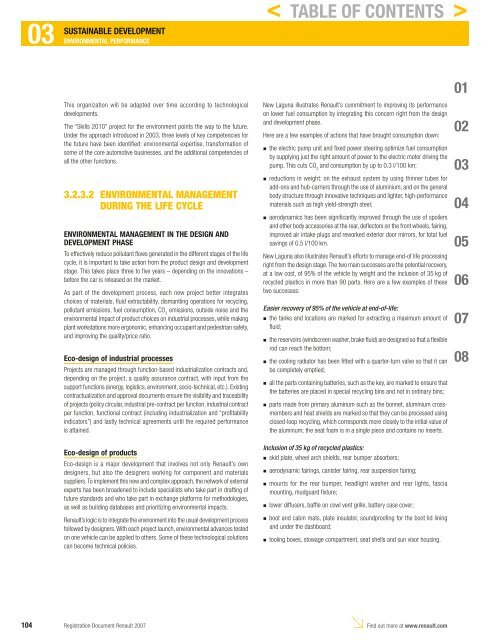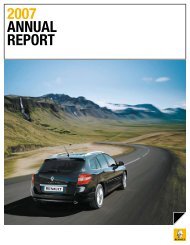2007 Interactive Registration Document - Renault
2007 Interactive Registration Document - Renault
2007 Interactive Registration Document - Renault
You also want an ePaper? Increase the reach of your titles
YUMPU automatically turns print PDFs into web optimized ePapers that Google loves.
03 ENVIRONMENTAL<br />
SUSTAINABLE DEVELOPMENT<br />
PERFORMANCE<br />
This organization will be adapted over time according to technological<br />
developments.<br />
The “Skills 2010” project for the environment points the way to the future.<br />
Under the approach introduced in 2003, three levels of key competencies for<br />
the future have been identifi ed: environmental expertise, transformation of<br />
some of the core automotive businesses, and the additional competencies of<br />
all the other functions.<br />
3.2.3.2 ENVIRONMENTAL MANAGEMENT<br />
DURING THE LIFE CYCLE<br />
ENVIRONMENTAL MANAGEMENT IN THE DESIGN AND<br />
DEVELOPMENT PHASE<br />
To effectively reduce pollutant fl ows generated in the different stages of the life<br />
cycle, it is important to take action from the product design and development<br />
stage. This takes place three to fi ve years – depending on the innovations –<br />
before the car is released on the market.<br />
As part of the development process, each new project better integrates<br />
choices of materials, fl uid extractability, dismantling operations for recycling,<br />
pollutant emissions, fuel consumption, CO 2 emissions, outside noise and the<br />
environmental impact of product choices on industrial processes, while making<br />
plant workstations more ergonomic, enhancing occupant and pedestrian safety,<br />
and improving the quality/price ratio.<br />
Eco-design of industrial processes<br />
Projects are managed through function-based industrialization contracts and,<br />
depending on the project, a quality assurance contract, with input from the<br />
support functions (energy, logistics, environment, socio-technical, etc.). Existing<br />
contractualization and approval documents ensure the visibility and traceability<br />
of projects (policy circular, industrial pre-contract per function, industrial contract<br />
per function, functional contract (including industrialization and “profi tability<br />
indicators”) and lastly technical agreements until the required performance<br />
is attained.<br />
Eco-design of products<br />
Eco-design is a major development that involves not only <strong>Renault</strong>’s own<br />
designers, but also the designers working for component and materials<br />
suppliers. To implement this new and complex approach, the network of external<br />
experts has been broadened to include specialists who take part in drafting of<br />
future standards and who take part in exchange platforms for methodologies,<br />
as well as building databases and prioritizing environmental impacts.<br />
<strong>Renault</strong>’s logic is to integrate the environment into the usual development process<br />
followed by designers. With each project launch, environmental advances tested<br />
on one vehicle can be applied to others. Some of these technological solutions<br />
can become technical policies.<br />
New Laguna illustrates <strong>Renault</strong>’s commitment to improving its performance<br />
on lower fuel consumption by integrating this concern right from the design<br />
and development phase.<br />
Here are a few examples of actions that have brought consumption down:<br />
the electric pump unit and fi xed power steering optimize fuel consumption<br />
by supplying just the right amount of power to the electric motor driving the<br />
pump. This cuts CO 2 and consumption by up to 0.3 l/100 km;<br />
reductions in weight: on the exhaust system by using thinner tubes for<br />
add-ons and hub-carriers through the use of aluminium, and on the general<br />
body structure through innovative techniques and lighter, high-performance<br />
materials such as high yield-strength steel;<br />
aerodynamics has been signifi cantly improved through the use of spoilers<br />
and other body accessories at the rear, defl ectors on the front wheels, fairing,<br />
improved air intake plugs and reworked exterior door mirrors, for total fuel<br />
savings of 0.5 l/100 km.<br />
New Laguna also illustrates <strong>Renault</strong>’s efforts to manage end-of life processing<br />
right from the design stage. The two main successes are the potential recovery,<br />
at a low cost, of 95% of the vehicle by weight and the inclusion of 35 kg of<br />
recycled plastics in more than 90 parts. Here are a few examples of these<br />
two successes:<br />
Easier recovery of 95% of the vehicle at end-of-life:<br />
n the tanks and locations are marked for extracting a maximum amount of<br />
fl uid;<br />
the reservoirs (windscreen washer, brake fl uid) are designed so that a fl exible<br />
rod can reach the bottom;<br />
the cooling radiator has been fi tted with a quarter-turn valve so that it can<br />
be completely emptied;<br />
all the parts containing batteries, such as the key, are marked to ensure that<br />
the batteries are placed in special recycling bins and not in ordinary bins;<br />
parts made from primary aluminum such as the bonnet, aluminium crossmembers<br />
and heat shields are marked so that they can be processed using<br />
closed-loop recycling, which corresponds more closely to the initial value of<br />
the aluminum; the seat foam is in a single piece and contains no inserts.<br />
Inclusion of 35 kg of recycled plastics:<br />
n skid plate, wheel arch shields, rear bumper absorbers;<br />
aerodynamic fairings, canister fairing, rear suspension fairing;<br />
mounts for the rear bumper, headlight washer and rear lights, fascia<br />
mounting, mudguard fi xture;<br />
lower diffusers, baffl e on cowl vent grille, battery case cover;<br />
boot and cabin mats, plate insulator, soundproofi ng for the boot lid lining<br />
and under the dashboard;<br />
tooling boxes, stowage compartment, seat shells and sun visor housing.<br />
104 <strong>Registration</strong> <strong>Document</strong> <strong>Renault</strong> <strong>2007</strong><br />
Find out more at www.renault.com<br />
n<br />
n<br />
n<br />
n<br />
n<br />
n<br />
n<br />
n<br />
n<br />
n<br />
n<br />
n<br />
< TABLE OF CONTENTS ><br />
01<br />
02<br />
03<br />
04<br />
05<br />
06<br />
07<br />
08




